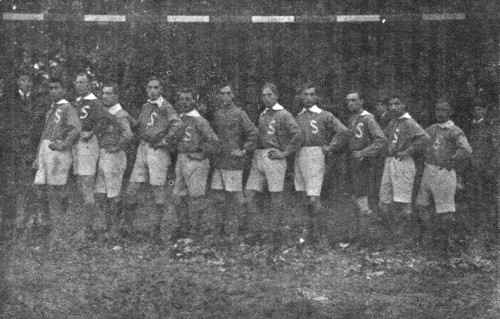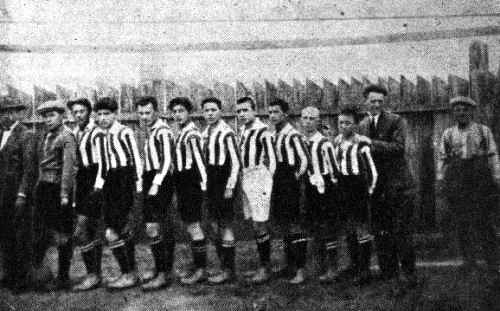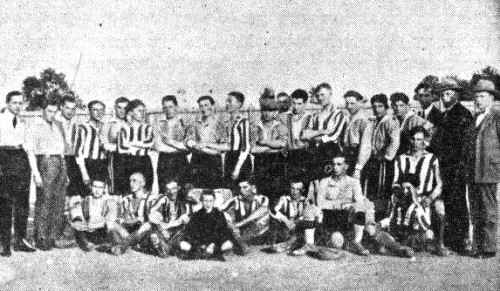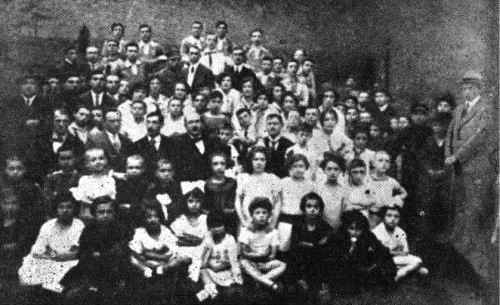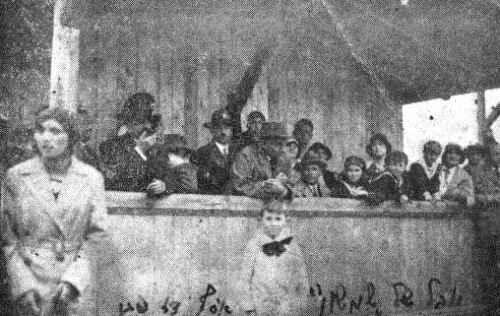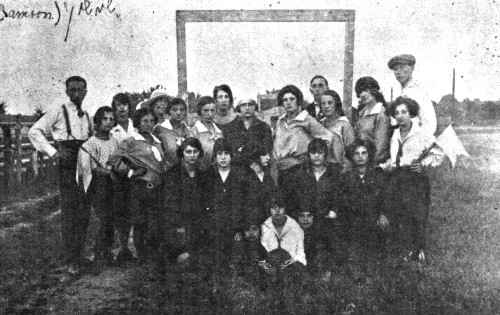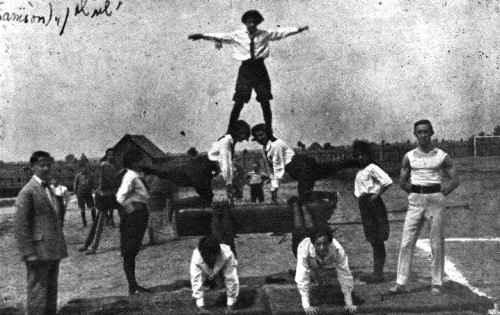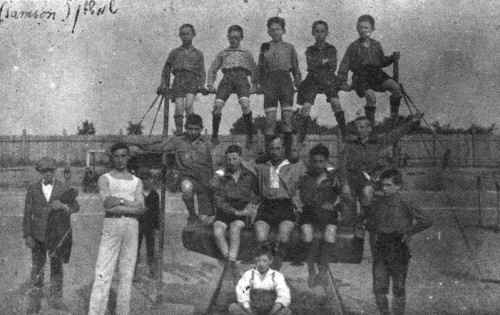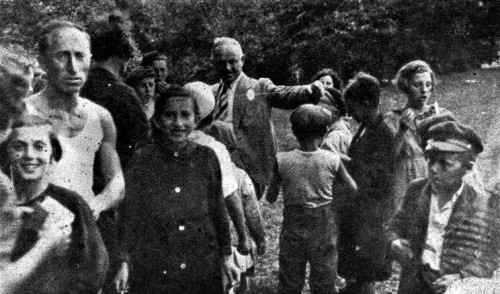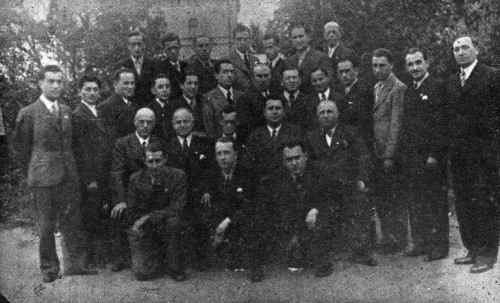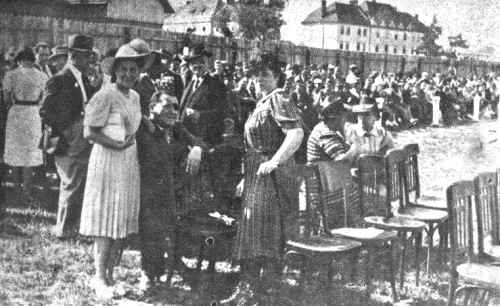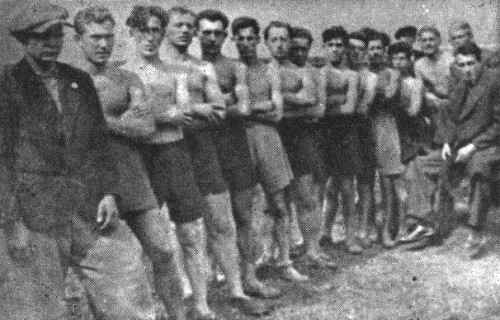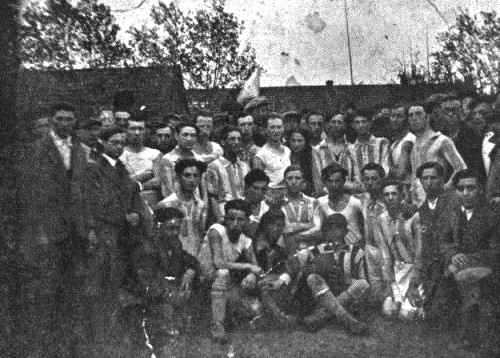[Page 714]
About the Jewish Sports–Gymnastics Organizations in Tarnow
by Dr. Avraham Chomet
Translated by Gloria Berkenstat Freund
[Page 715]
The sports–gymnastic movement in the Jewish neighborhood in Tarnow developed during the early years when Zionism ripened. Zionism thrust the slogan to raise an invaluable, proud Jew who would break with the Exile, straighten his back and build the old–new homeland in Eretz–Yisroel.
At first there were only sporadic attempts, individual appearances by young Jews. In 1912, the first Jewish sports club, Shimshon (Samson) arose in Tarnow. In connection with the 20th anniversary of the Shimshon Gymnastic Society, Henrik Flur, one of the first enthusiasts of the physical development of the young Jews, a devoted Zionist and sports activist in Tarnow, published an article in Tygodnik Żydowski [Jewish Weekly] (no. 37, 16.9.32) in which he described the beginning of the development of this sports club:
“Twelve young gymnasts, Munya and Ignac Ofner, the Jassi brothers, Shmuel Flur, Korec, Herszderfer, Drobner, Kam, Szmindling, Shmuel Grinhut and Emil Adler sat on the field, Pod Lipames, in the spring of 1912. The Sport Club Shimshon was created to the resounding shouts of “bravo” under the chairmanship of Eliyahu Flur and under the protection of Dr. Szpan. Right on the spot, it should be understood, without the necessary uniforms, the first training began with balls that were bought with the fund that was collected from the 10 and 14–year old boys. The first football match was organized very quickly, after the creation of the charter, having it certified and signed by the honorary chairman, Dr. Szpan.”…
The appearance of the first 112 Jewish football players evoked great interest and enthusiasm among the nationally inclined Tarnow Jewry. Although at first these athletes had to endure harassment from their parents because they, the parents, did not yet have the proper understanding of the physical development of the young.
In 1916 a second sports club, Makkabi, arose using the example of Shimshon, whose managing committee, consisting of Bernsztajn, Izraelowicz, Goldfinger and Totenberg, agreed to a unification with
[Page 716]
|
|
The first footballers from the Shimshon football club in 1912
From left to right: Fenichel (now Dr. Fenichel in Israel), Munya Ofner, of blessed memory, Korec, Dovid Klajnhendler, of blessed memory,
?, Shmuel Flur, of blessed memory, ?, Jortner, of blessed memory, Gans, of blessed memory, Herszderfer, of blessed memory. |
[Page 717]
Shimshon and thus the number of members of the united sport club grew. The club could not be satisfied with only the one football section and it was decided to create a gymnastic section. However, in order to fulfill the new task, the club had to enlarge its scope and draw to the work new people in the leadership. This work was undertaken at that time by Dr. Yeshayahu Fajg and Henrik Flur.
In 1918 after the interruption for the World War, the general managing committee of Shimshon, under the chairmanship of Dr. Fajg, decided to change its name to “Jewish Sports–Gymnastics Society, Shimshon, which was needed to emphasize that the purpose of the society, among others, was to practice all kinds of sports and gymnastics. When the Safa Berura [clear language] Society bought its own house (at Saint Anne Street, number 1) for the Hebrew School, the gatherings of Shimshon took place in a room in the house, which thanks to the untiring work of Dr. Fajg, Henrik Flur and Engineer Lajchter, was remodeled into a beautiful gymnasium [where there were] gymnastic courses for children and young people. In order to collect the necessary funds, in 1918 the Shimshon managing committee arranged its first reduta (ball), which was repeated every year with great success. The best evidence of the rising interest in Shimshon is the fact that many members of the club who left Tarnow and even emigrated [outside Poland] sent larger sums of money for the club.
Shimshon had to thank the managing committee members, Captain Frank, Dr. Szalit, Dr. Grajf, Dr. Adolf Kac, Dr. Betsalel Szpajzer, who spared no effort or exertion when it concerned the work of developing the sports club. At the initiative of Dr. Grajf and Dr. Kac, a tennis section was created in 1921, which had great success in many circles of Jewish society as a whole in Tarnow. It is enough to mention that during the tennis tournament that took place in Tarnow in 1928 and was arranged by the Jewish sports–gymnastic clubs in Poland, joined by the world union, Makkabi, there were Tarnow tennis players from Shimshon – Miss Simkha, Brandszteter, Holender, Avraham Klajn, Ormian, Rubin and Simkha. The cup, funded by the Krakow Makkabi, was won by the athletes from Tarnow Shimshon. Tennis players from Bilicer (Bielsker) HaKoah [strength] and from the Krakow Makkabi took part.
At great cost, a place for tennis games was built at the municipal Szic Gardens, where football competition would also take place.
[Page 718]
|
|
| Shimshon football players in 1920 |
Thanks to the work of the then existing managing committee, at whose head stood Dr. Emil Merc, Dr. Szenfeld, the tennis section brought the Shimshon sports club much glory and recognition in the sports world, because since that time the yearly tennis championship of the Jewish clubs, organized by the world union, Makkabi, took place at the Shimshon field.
When the Tarnow city hall banned the playing of football at the municipal garden, the managing committee of Shimshon tried to obtain a location for its own playing field. After two years of effort, a municipal location near the shooting field at Bem Street was provided. After leveling the ground, a playing field that had great success with the young Tarnow Jews was created.
The sports club Shimshon encompassed an even wider circle of young people and had prestige among the Jewish population in the city.
Particularly popular was the gymnastic section, which had an opportunity to lead more widespread activity thanks to the large gymnastic room in the building of the former school named for Baron Hirsch, which was allocated by the trustees of Baron Hirsch's foundation in Warsaw.
Every year new activities arose, such as: light athletics, sports games, heavy athletics, bicycle tours, ping–pong. The latter produced
[Page 719]
|
|
| Football players from Shimshon and from the Polish club Krakowia from Krakow before a competition in 1920 |
one of the best ping–pong players in Poland – M. Szif – educated by HaNoar HaTzioni [Zionist Youth]. M. Szif won the championship of Poland in ping–pong for Shimshon and represented Poland in international ping–pong
|
|
The first public gymnastic appearance of the “Shimshonists” in 1923
In the third row, sitting from the left: Dr. Adolf Kac, may his memory be blessed, Henrik Flur, may his memory be blessed, Dr. Yeshayahu Fajg |
[Page 720]
competitions. A running track and a bicycle track (for bicycle races) was arranged at the sports area.
In 1928 a managing committee was elected with Dr. Emil Merc as chairman and Henrik Flur as vice chairman, which took as its task the building of its own house for physical education. A reserve fund was created for this purpose. In 1928 the football section possessed such significant players as Gros, Kac, Miler, Gutter, Blonder, Mewes, Rubinfeld, Lustig and Owida.
In 1929 Karol Szancer was elected as chairman and Henrik Flur as vice chairman of Shimshon. In addition, Mrs. Dr. Wajs, Zigmunt Fenichel, Zigmunt Funarski, Dr. Muszkantenblit, M. Szpilman, Dr. Taubenschlag. were drawn to the work. During the term of office of the above–mentioned managing committee, Shimshon received its own flag. On the 29th of June 1930, the 18th anniversary of the rise of Shimshon, the solemn opening of its own sports stadium and the unveiling of the flag took place, bound with an impressive series of sports events, particularly from the gymnastic group, under the leadership of the experienced sports teacher, Messinger, who over the years led the gymnastic section of Shimshon.
In 1932 Shimshon celebrated the 20th anniversary of its existence. The successfully carried out sports celebration, ending with a sports academy, demonstrated the great popularity of the sports club among the Jewish population in Tarnow. We read in Tygodnik Żydowski [Jewish Weekly] of the 2nd of November 1932 (no. 36):
|
|
| At the 20th anniversary of the existence of Shimshon
From left to right: Dr. Shmuel Szpan, Henrik Flur and Dr. Edward Szalit and Dr. Lezer |
[Page 721]
|
|
| Shimshon women's gymnastic section |
[Page 722]
“After all of the Shimshon athletes marched out onto the playing field to the accompaniment of the railroad orchestra and arranged themselves in a column, the official part of the solemn assembly began with the speeches of greeting from the representative of Shimshon, Mr. Zigmund [previously Zigmunt] Fenichel. Then Dr. Szalit spoke in the name of the Tarnow city hall, Major Maskala in the name of leaders of the local garrison of the 16th infantry regiment, the priest, Dr. Rec in the name of the saving bank, Dr. Alfred Bekman in the name of the Makkabi World Federation, Dr. W. Szenker in the name of the executive of the Zionist organization in Krakow and of the Zionist organization in Tarnow, Captain Franczkewicz in the name of the county sports federation, Rumanski in the name of the Polish workers sports club, “Metal,” Dr. Gold in the name of the gymnastic club Makkabi in Krakow, Dr. Fajg – Lemberg Hashmonai, Henrik Szpilman – Zionist youth organization, as well as greetings in the name of HaNoar HaTzioni [the Zionist Youth], HaShomer Hatzair [The Youth Guard], Gordynia. The list of speakers was closed by the chairman of Shimshon, Engineer Karol Szancer, who thanked those delegates and guests in attendance and called on Tarnow as a whole to further support the club.
“After the welcoming speeches began the registering in the memory book of the society. Then the chairman, Engineer Szancer, decorated the praiseworthy members of the club. A golden award for service in the organizational area was received by Engineer Szancer, Henrik Flur, Zigmunt Fenichel, Shimeon Rajch, Leon Grabkowicz. The silver award: Dr. Y. Fajg, Eliyahu Flur, Leon Szpindler, Herman Ormian, Beno Edelsztajn, Yosef Man. A golden award for service in the sports area was received by Shmuel Flur, Dovid Klajnhendler, Herman Messinger, Henrik Szpilfojgel, and the silver award, Miss Wanda Simkha, Miss Ela Buch, Herman Guter, Zigmunt Meler, Zigmunt Holender. Then the chairman distributed small flags to all of the clubs that had taken part in the anniversary celebration. After distributing the citations, the leaders of all 12 active sports sections of the club hammered silver nails into the club flag. A procession took place for the newly unveiled flag and for the representatives of the regime. The image of the several hundred athletes, who paraded agilely and rhythmically under the sound of the orchestra delighted the eye.
That year Shimshon also took part in the Makkabiade [Maccabi Games] in Eretz–Yisroel; it sent its athletes as part of the general representation of the Jewish sports–gymnastic clubs in Poland. Shimshon closed its 20 years of activity with a positive balance,
[Page 723]
|
|
| Gymnastic exercises for Jewish young people led by Herman Messinger [on the right] and Shmuel Grinhut [on the left] |
[Page 724]
|
|
Gymnastic exercises for Jewish school young people.
In the top row Moshe Klapholc (X [on the photograph]) – now Etzioni Judge in Haifa |
[Page 725]
showing significant development and good achievements in all areas of sports.
The Zionist managing committee members of Shimshon immediately demanded the inclusion of its Zionist position in the bylaws of the club, underlining that the sports–gymnastic movement among the young Jews is only a means to an end. A struggle also began in the club itself to remove the black line from all identification cards on which the printed words, “The task of the society is also to awaken the national consciousness,” were crossed out.
At the general meeting that took place in October 1932, Engineer Szancer was elected as honorary chairman, Dr. M Menderer as actual chairman, an active Zionist, Henrik Flur as vice chairman. In addition to them, the following entered the managing committee: Maks Balzam, Magister [an academic degree] Y. Binensztok, Z. Fenichel, L. Grabowski, Y. Izraelowicz, De. Leibl, Prof. Malkiszer, A. Pomeranc, Shimeon Rajch, S. Ratenberg, Leon Szpindler and A. Wajnrib. Shimshon now became an outspoken Zionist club. This came to expression through the participation of the members in the work on behalf of Keren Kayemet L'Yisroel [Jewish National Fund] and of all of the official Zionist managing committees.
The general meeting, taking place in October 1933, inscribed the chairman in “the Golden Book” of Keren Kayemet as an expression of recognition of his service to the club.* At this meeting, the following were elected to the managing committee: Dr. M. Menderer (chairman), Dr. Y. Fajg (vice chairman), Argand, Binensztok, Henrik Flur, Grabowski, Guter, Kac, Dr. Leibl, Pomeranc, Ormian, Szpindler, Wajnrib, Rajch, Dr. Lantner. To the audit committee: Dr. Grinberg, Izraelowicz and Dr. Szenkel.
*[Translator's note: the Golden Book was the Jewish National Fund's “Book of Honor” in which donations could be recorded in honor of a person's accomplishments.]
A chess section was created to which the best local players belonged, such as Magister Perlberg (perished in 1947 after the liberation, while swimming in the Vistula [River] in Warsaw), the younger Perlberg, Radomyshler, Wimisner, Bernfeld, Kurc and Alban. The same year, the Shimshon ski section was accepted as a member of the Polish Ski Union.
The continued development of the Shimshon society went even further along the Zionist line. The energetic and diligent chairman, Dr. Menderer, was able to report at the general meeting of Shimshon, which took place on the 18th of December 1939, that the managing committee had bought a spot for their own sports stadium; that a significant sum had been paid to build Kfar HaMakkabi [kibbutz [communal settlement] in northern Israel]; that Milek Szif, a member of Shimshon
[Page 726]
|
|
| Dr. Menderer, of blessed memory, the chairman of Shimshon, with young people at Shimshon's summer colony |
[Page 727]
|
|
| The managing committee of Shimshon in 1925 |
[Page 728]
won the individual championship in Poland in ping–pong in Czenstochow and that the same Milek Szif had taken part in the world championship competition in London as the representative of Poland; that the Shimshon ping–pong section had received the honorary title of champion of Poland in ping–pong for the fourth time. A new managing committee of the following composition was chosen for the last time at the above–mentioned meeting: chairman (for the second time) Dr. Menderer, vice chairman Dr. Ignaci Zajdenwerg, Magister Yakov Binensztok, Nekhemia Birnfeld, Zigmunt Flajszer, Leon Grabkowicz, Henrik Guter, Dovid Klajnhendler, Dr. Adolf Kac, Moniek Kac, Dr. Wolf Mondel, Henrik Mesinger, Z. Miller, H. Ormian, Shimeon Rajch, Y. Rajn, S. Zigfrid, Hugo Szpiler, Teodor Rot, Y. Tajtelbaum, A. Wajnrib and to the audit committee: Dr. Grinberg, Dr. B. Czech and to the association's tribunal: Dr. A. Chomet, Henrik Flur and Engineer M. Rajch.
The last managing committee quickly carried out its designated tasks. In the spring of 1939 their completed Shimshon sports stadium was presented. The solemn opening of the stadium drew masses of people from all strata of the Jewish population, representatives of political parties, the military and regime organs. Appearing with speeches of greeting were Dr. M. Menderer, chairman of Shimshon, Dr. A. Chomet in the name of the Jewish kehile [organized Jewish community], as well as representatives of the administrative district and the military. After the speeches, a procession of all of the Zionist youth organizations with their flags took place. This was the last procession of the Zionist young people in Tarnow before the outbreak of the Second World War.
A second Jewish sports club under the name Z.M.S. (Zydowska Młodzież Sportowa – Jewish Sports Youth) arose in the later years, which also joined the World Federation Makkabi and was under the influence of the Revisionist movement. This club developed sufficiently active and widespread sports activities and even acquired its own sports field. But all attempts to unite Shimshon and the Z.M.S. ended in failure.
In 1933, a managing committee of the following composition was elected at the general gathering of Z.M.S.: Dr. B. Szpajzer – chairman, W. Gutwirt – vice chairman, E. Salpeter – secretary, M. Gruszow – treasurer, M. Szpilman, A. Lis, M. Abend, M. Lezer.
After the First World War, sports clubs also arose among the Jewish workers. The sports and [bicycle] touring union, Morgenstern [Morningstar], was created by the Bund and the Gwiazda–Shtern [the Polish and Yiddish words “star”] sports club was created by the left Poalei–Zion [Workers of Zion – Marxist–Zionist movement]. We read the details about these two sports unions in the previous chapters.
[Page 729]
|
|
The solemn opening of the Shimshon Sports Stadium in 1939
Standing from the left: Dr. Anzelm Bazler
Sitting: Dr. Shlomo Goldberg and his wife and daughter and Mrs. Menderer and Ester Chomet |
[Page 730]
|
|
| A group of athletes at the Tarnow Sport Union, Morgenstern–Jutrzenka [Morning Star – Morgenstern – Yiddish; Jutrzenka – Polish] in 1933 |
|
|
| HaPoel [The Worker] Sports Club |
[Page 731]
In 1933 the workers sport club, Hapoel [the worker], was founded by the League for Working Eretz–Yisroel, which had football, sports games and light athletics divisions.
All Jewish sports clubs competed among themselves for a better game, a better place in the sports movement, and the individual sports achievements of each Jewish sports club filled the hearts of the Tarnow Jewish population with pride.
Tarnow lays in ruin and with it the Jewish sports clubs.
This material is made available by JewishGen, Inc.
and the Yizkor Book Project for the purpose of
fulfilling our
mission of disseminating information about the Holocaust and
destroyed Jewish communities.
This material may not be copied,
sold or bartered without JewishGen, Inc.'s permission. Rights may be
reserved by the copyright holder.
JewishGen, Inc. makes no representations regarding the accuracy of
the translation. The reader may wish to refer to the original material
for verification.
JewishGen is not responsible for inaccuracies or omissions in the original work and cannot rewrite or edit the text to correct inaccuracies and/or omissions.
Our mission is to produce a translation of the original work and we cannot verify the accuracy of statements or alter facts cited.
 Tarnow,Poland
Tarnow,Poland
 Yizkor Book Project
Yizkor Book Project
 JewishGen Home Page
JewishGen Home Page
Yizkor Book Director, Lance Ackerfeld
This web page created by Jason Hallgarten
Copyright © 1999-2025 by JewishGen, Inc.
Updated 31 Jul 2020 by JH
